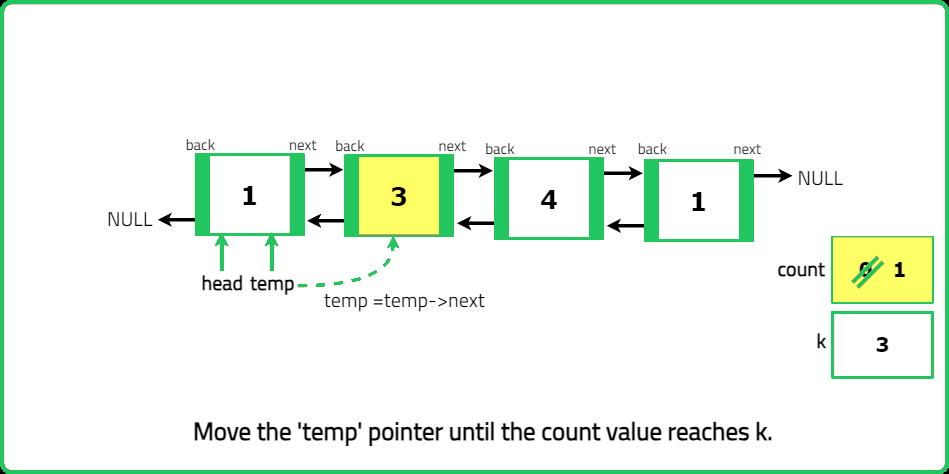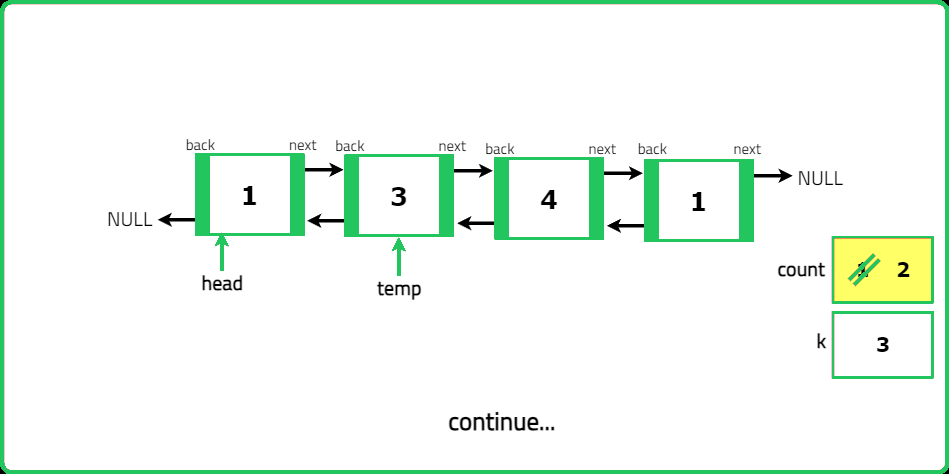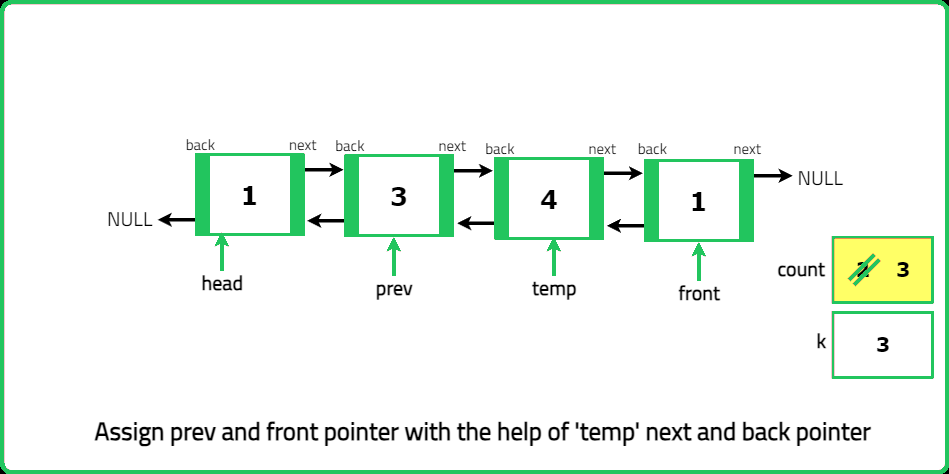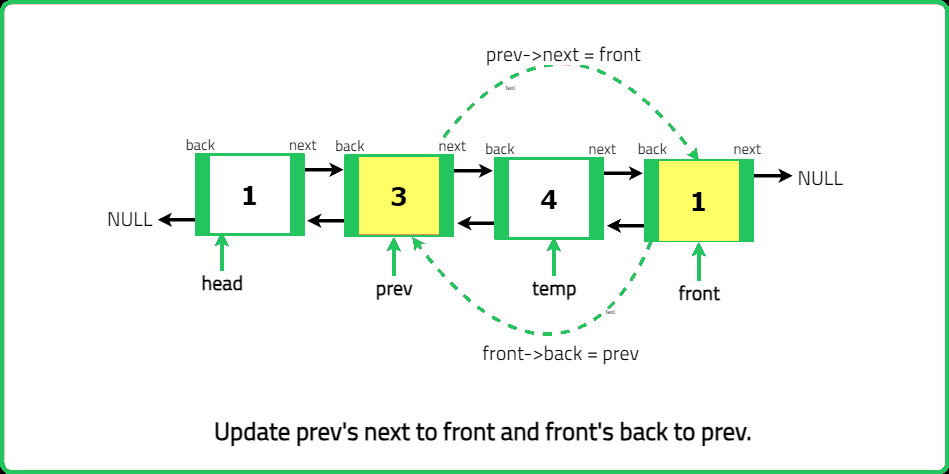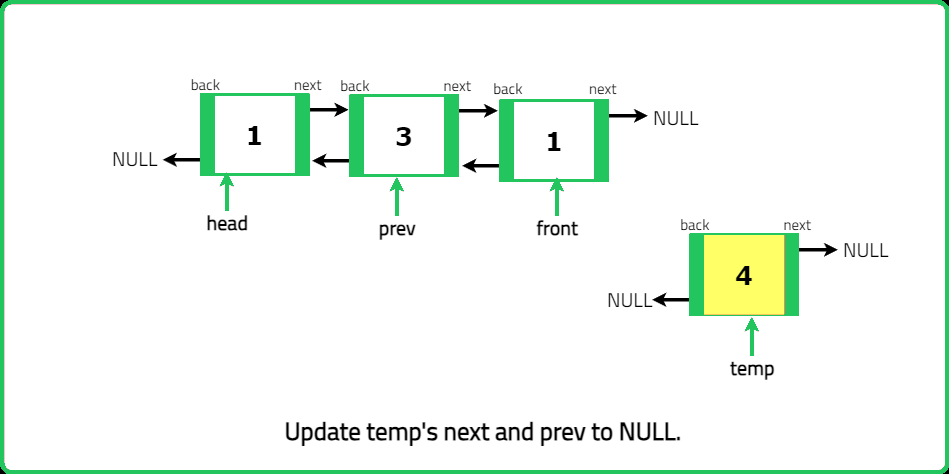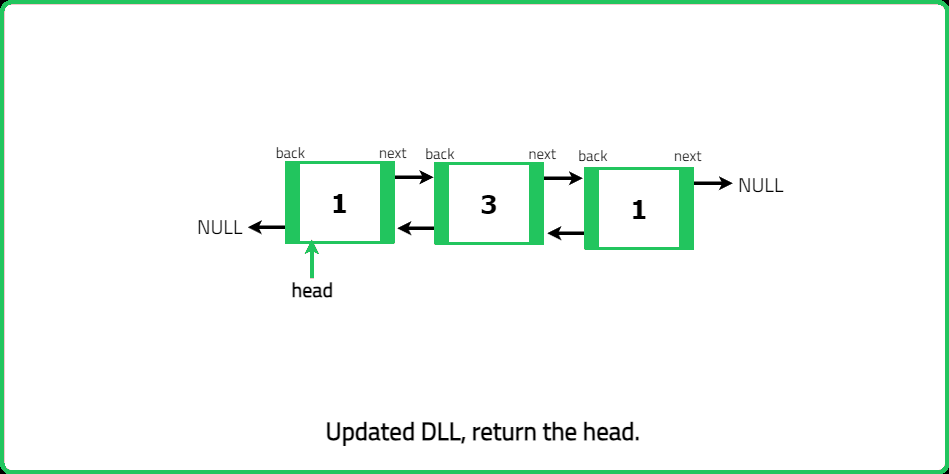123456789101112131415161718192021222324252627282930313233343536373839404142434445464748495051525354555657585960616263646566676869707172737475767778798081828384858687888990919293949596979899100101102103104105106107108109110111112113114115116117118119120121122123124125126127128129130131132133134135136137138139140141
#include <bits/stdc++.h>
using namespace std;
// Definition of doubly linked list
struct ListNode
{
int val;
ListNode *next;
ListNode *prev;
ListNode()
{
val = 0;
next = NULL;
prev = NULL;
}
ListNode(int data1)
{
val = data1;
next = NULL;
prev = NULL;
}
ListNode(int data1, ListNode *next1, ListNode *prev1)
{
val = data1;
next = next1;
prev = prev1;
}
};
// Solution class
class Solution {
public:
// Function to remove the Kth element
ListNode* deleteKthElement(ListNode* head, int k) {
// If the list is empty, return nullptr
if (head == nullptr)
return nullptr;
int count = 0;
ListNode* kNode = head;
// Traverse the list
while (kNode != nullptr) {
count++;
if (count == k) break;
kNode = kNode->next;
}
// If k is larger
if (kNode == nullptr) return head;
// Update the pointers
ListNode* prev = kNode->prev;
ListNode* front = kNode->next;
// If node to be deleted is only node in list
if (prev == nullptr && front == nullptr) {
delete kNode;
return nullptr;
}
// If node to be deleted is head of list
else if (prev == nullptr) {
head = front;
front->prev = nullptr;
}
// If node to be deleted is tail of list
else if (front == nullptr) {
prev->next = nullptr;
}
// If node to be deleted is in middle of list
else {
prev->next = front;
front->prev = prev;
}
// Free memory of the deleted node
delete kNode;
// Return modified list head
return head;
}
};
// Helper Function to convert an array to a doubly linked list
ListNode* arrayToLinkedList(vector<int> &nums) {
// If array is empty, return nullptr
if (nums.empty()) return nullptr;
// Create head node with first element of the array
ListNode* head = new ListNode(nums[0]);
// Initialize 'prev' to the head node
ListNode* prev = head;
for (int i=1; i < nums.size(); i++) {
// Create a new node
ListNode* temp = new ListNode(nums[i], nullptr, prev);
// Update 'next' pointer
prev->next = temp;
// Move 'prev' to newly created node
prev = temp;
}
// Return head
return head;
}
// Helper Function to print the linked list
void printLL(ListNode* head) {
while (head != NULL) {
cout << head->val << " ";
head = head->next;
}
cout << endl;
}
int main() {
vector<int> nums = {1, 2, 3, 4, 5};
int k = 2;
// Creating the doubly linked list from given array
ListNode* head = arrayToLinkedList(nums);
// Print the Original list
cout << "Original List: ";
printLL(head);
// Create an instance of Solution class
Solution sol;
// Function call to delete the kth Node of the doubly linked list
head = sol.deleteKthElement(head, k);
// Print the Modified list
cout << "Modified list: ";
printLL(head);
return 0;
}
123456789101112131415161718192021222324252627282930313233343536373839404142434445464748495051525354555657585960616263646566676869707172737475767778798081828384858687888990919293949596979899100101102103104105106107108109110111112113114115116117118119120121122123124125126127128129130131132133134
// Definition of doubly linked list
class ListNode {
int val;
ListNode next;
ListNode prev;
ListNode() {
val = 0;
next = null;
prev = null;
}
ListNode(int data1) {
val = data1;
next = null;
prev = null;
}
ListNode(int data1, ListNode next1, ListNode prev1) {
val = data1;
next = next1;
prev = prev1;
}
}
// Solution class
class Solution {
// Function to remove the Kth element
public ListNode deleteKthElement(ListNode head, int k) {
// If the list is empty, return null
if (head == null)
return null;
int count = 0;
ListNode kNode = head;
// Traverse the list
while (kNode != null) {
count++;
if (count == k) break;
kNode = kNode.next;
}
// If k is larger than the list size
if (kNode == null) return head;
// Update the pointers
ListNode prev = kNode.prev;
ListNode front = kNode.next;
// If node to be deleted is the only node in the list
if (prev == null && front == null) {
return null;
}
// If node to be deleted is head of the list
else if (prev == null) {
head = front;
front.prev = null;
}
// If node to be deleted is tail of the list
else if (front == null) {
prev.next = null;
}
// If node to be deleted is in the middle of the list
else {
prev.next = front;
front.prev = prev;
}
// Return modified list head
return head;
}
}
// Main class
class Main {
// Helper Function to convert an array to a doubly linked list
private static ListNode arrayToLinkedList(int[] nums) {
// If array is empty, return null
if (nums.length == 0) return null;
// Create head node with first element of the array
ListNode head = new ListNode(nums[0]);
// Initialize 'prev' to the head node
ListNode prev = head;
for (int i = 1; i < nums.length; i++) {
// Create a new node
ListNode temp = new ListNode(nums[i], null, prev);
// Update 'next' pointer
prev.next = temp;
// Move 'prev' to newly created node
prev = temp;
}
// Return head
return head;
}
// Helper Function to print the linked list
private static void printLL(ListNode head) {
while (head != null) {
System.out.print(head.val + " ");
head = head.next;
}
System.out.println();
}
// main method
public static void main(String[] args) {
int[] nums = {1, 2, 3, 4, 5};
int k = 2;
// Creating the doubly linked list from given array
ListNode head = arrayToLinkedList(nums);
// Print the Original list
System.out.print("Original List: ");
printLL(head);
// Create an instance of Solution class
Solution sol = new Solution();
// Function call to delete the kth Node of the doubly linked list
head = sol.deleteKthElement(head, k);
// Print the Modified list
System.out.print("Modified list: ");
printLL(head);
}
}
123456789101112131415161718192021222324252627282930313233343536373839404142434445464748495051525354555657585960616263646566676869707172737475767778798081828384858687888990919293949596979899100101102103
# Definition of doubly linked list
class ListNode:
def __init__(self, data1=0, next1=None, prev1=None):
self.val = data1
self.next = next1
self.prev = prev1
# Solution class
class Solution:
# Function to remove the Kth element
def deleteKthElement(self, head, k):
# If the list is empty, return None
if head is None:
return None
count = 0
kNode = head
# Traverse the list
while kNode is not None:
count += 1
if count == k:
break
kNode = kNode.next
# If k is larger than the list size
if kNode is None:
return head
# Update the pointers
prev = kNode.prev
front = kNode.next
# If node to be deleted is the only node in the list
if prev is None and front is None:
return None
# If node to be deleted is head of the list
elif prev is None:
head = front
front.prev = None
# If node to be deleted is tail of the list
elif front is None:
prev.next = None
# If node to be deleted is in the middle of the list
else:
prev.next = front
front.prev = prev
# Return modified list head
return head
# Helper Function to convert an array to a doubly linked list
def arrayToLinkedList(nums):
# If array is empty, return None
if not nums:
return None
# Create head node with first element of the array
head = ListNode(nums[0])
# Initialize 'prev' to the head node
prev = head
for i in range(1, len(nums)):
# Create a new node
temp = ListNode(nums[i], None, prev)
# Update 'next' pointer
prev.next = temp
# Move 'prev' to newly created node
prev = temp
# Return head
return head
# Helper Function to print the linked list
def printLL(head):
while head is not None:
print(head.val, end=" ")
head = head.next
print()
if __name__ == "__main__":
nums = [1, 2, 3, 4, 5]
k = 2
# Creating the doubly linked list from given array
head = arrayToLinkedList(nums)
# Print the Original list
print("Original List: ", end="")
printLL(head)
# Create an instance of Solution class
sol = Solution()
# Function call to delete the kth Node of the doubly linked list
head = sol.deleteKthElement(head, k)
# Print the Modified list
print("Modified list: ", end="")
printLL(head)
123456789101112131415161718192021222324252627282930313233343536373839404142434445464748495051525354555657585960616263646566676869707172737475767778798081828384858687888990919293949596979899100101102103104105106107108109110111112113114115116
// Definition of doubly linked list
class ListNode {
constructor(data1 = 0, next1 = null, prev1 = null) {
this.val = data1;
this.next = next1;
this.prev = prev1;
}
}
// Solution class
class Solution {
// Function to remove the Kth element
deleteKthElement(head, k) {
// If the list is empty, return null
if (head === null)
return null;
let count = 0;
let kNode = head;
// Traverse the list
while (kNode !== null) {
count++;
if (count === k) break;
kNode = kNode.next;
}
// If k is larger than the list size
if (kNode === null) return head;
// Update the pointers
let prev = kNode.prev;
let front = kNode.next;
// If node to be deleted is the only node in the list
if (prev === null && front === null) {
return null;
}
// If node to be deleted is head of the list
else if (prev === null) {
head = front;
front.prev = null;
}
// If node to be deleted is tail of the list
else if (front === null) {
prev.next = null;
}
// If node to be deleted is in the middle of the list
else {
prev.next = front;
front.prev = prev;
}
// Return modified list head
return head;
}
}
// Helper Function to convert an array to a doubly linked list
function arrayToLinkedList(nums) {
// If array is empty, return null
if (nums.length === 0) return null;
// Create head node with first element of the array
let head = new ListNode(nums[0]);
// Initialize 'prev' to the head node
let prev = head;
for (let i = 1; i < nums.length; i++) {
// Create a new node
let temp = new ListNode(nums[i], null, prev);
// Update 'next' pointer
prev.next = temp;
// Move 'prev' to newly created node
prev = temp;
}
// Return head
return head;
}
// Helper Function to print the linked list
function printLL(head) {
while (head !== null) {
process.stdout.write(head.val + " ");
head = head.next;
}
console.log();
}
const main = () => {
const nums = [1, 2, 3, 4, 5];
const k = 2;
// Creating the doubly linked list from given array
let head = arrayToLinkedList(nums);
// Print the Original list
console.log("Original List: ");
printLL(head);
// Create an instance of Solution class
let sol = new Solution();
// Function call to delete the kth Node of the doubly linked list
head = sol.deleteKthElement(head, k);
// Print the Modified list
console.log("Modified list: ");
printLL(head);
}
main();

